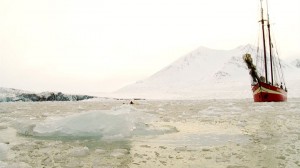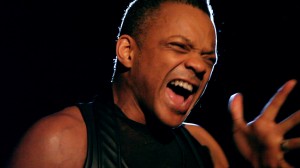Janet Biggs at Winkleman gallery.
Auden went to the Arctic. Iceland, 1936. He was much taken with the Northern desolation of nature. He was young still. Searching, as they say, for ideals. For the right politics, the right sexuality, the right turn of poetry. (It was of course the last that came easiest to him). While there Auden penned a Letter to Lord Byron. A verse letter, a poem to a God of English poetry. A God who, as it happens, also went searching for ideals that were very much kin to those of Auden’s search. Of Iceland Auden wrote to Byron:
The North, though, never was your cup of tea;
“Moral” you thought it so you kept away.
Moral indeed. Stay away from morality. Byron sort of did. Far away. In Greece at the end. Struggling for a political and sexual morality of his own. Auden? Him too, far away from the far north in some dive on 52rd st and on, and on, and on in New York, mapping his mid-century morality of poetics, Freud and sexuality.
And Janet Biggs? She went too to the Arctic. Svalbad, A Norwegian archipelago seemingly, on maps at least, adrift from the rest of Europe and paddling further up the page toward the “Moral” North. She too has sent back a poem –a film-essay– on the search for morality, sexuality and narrative order. It is showing a little south of the long gone dives of 52rd st. 27th st. Winkelman gallery to be precise.
Biggs is showing three videos comprised of material shot on her journeys to Svalbad. Long slow takes travel through the Arctic terrain. Ice, glacial horizons, frigid water and barren land populated by an occasional polar bear, a canoeist come actor and a miner working in what has been Svalbad’s sustaining (if that is the word) economy for many decades of territorial dispute between, and ravaging by, various European industrial conglomerates and governments. This material is intercut with footage shot in New York interior settings of individual performers. In one case, in the video Fade to White, Biggs films countertenor John Kelley wanly intoning a lament for unnamed and unknown loss. In a second video, Brightness All Around, Biggs films Bill Coleman singing/performing a high octane, club come lounge act. These two videos are presented face to face at separate ends of the gallery and run alternately as if in some back and forth dialogue.
The North is moral? Oft times it seems terminal. It is less the case that it is post civilization, more that the possibility of civilization is foreclosed. Some of the best footage in Biggs’s films speaks to this. Below ground the mineshafts and the toil performed both in making those shafts and in the work of mining them bespeak a vastness of effort for a terrifyingly meager sense of reward. The machinery pummels the arctic, the latter corrodes, the former rusts and then we start all over again. Above ground too the landscape brooks few civilizing scars. Brrr! And thus I honestly liked the films in Biggs’ show. I am drawn to the north. To the spare landscape, the fear, the unrequited naturalness of it all.
But the terms of the work, as determined by its formal choices of editing and its implied relationship to narrative, are that we watch loosely anchored images drift by, happily unexplained and unmotivated in their connection to one another. And this is all for the good. Because it is the case that the makers of video art, and the viewers of video art have together –in many cases but not all– foresworn the very real delights of Hollywood’s long established and ongoing system of continuity editing and narrative seduction. So much the better I say! That too is a moral decision. Those very real Hollywood delights applied their seductive fig leaf to so many questions of meaning and visual pleasure which various counter-cinemas have sought to rearticulate in less palliative films than Hollywood could nightmare of. But what then are we all to do, compact between video-art maker and video-art viewer having been made, with the often lugubrious the often beguiling enactments of said video art? Well, we can sit back and be wafted over by enthralling visual innovations and pleasures as with anything from, say, Brakhage to Rist. Or, another tack, we could connect the dots laid out for us from Hollis Frampton to Christian Marclay. Toying as they do with Hollywood’s very system of montage and meaning.
The problem comes when the dots don’t quite link up. For example on one of the occasions while I was at Winkelman to see Biggs’ work one viewer whispered (loudly) to their partner, “why does he have a gun” (referring to the canoeist/hiker in Fade to White). Poor viewing etiquette aside, well yes we are going to ponder questions like that when you hand your actor a gun. Biggs’ films trade in truncated narrative gestures, allusions toward a fledgling continuity between shots and thus to a sense of motivation: as such they lead us, the viewers, toward the expectation that things will be explained. Indeed why does he have a gun?
In one sense this is all a smart gambit. The classical cinema of Hollywood tortured itself to provide yet hide the motivation for everything from editing transitions to close-ups and eyeline matches, to why the actor has a gun. And, thus, travestying the prerogatives of classical narration has credentials. The surrealists did it. Markopoulos did it. Yet in large part the cinematic avant-gardes elided the problem by eschewing narrative altogether. Even the poetics of, say, Deren and Hammid, courting narrative as it did, offered such a rapid paced shift of images that it capitalized upon the trope of shocking juxtapositions.
But I must admit to being lost, cast adrift by Bigg’s compilation of images. I am sure footed throughout the treacherous north. I can even take the gun-toting. It is when we collide with pleather clad “New York music guru” Bill Coleman or countertenor John Kelley that I stumble. Caught in the glare of the cut I am disoriented by the slamming shut of one iconographic door and the loud opening of an other.
I am asking to have it both ways. I know. I want the artist to not explain the narrative and let us all rely upon poetic drift. Yet I want to not be slammed by gratuitous collisions. The latter is, I believe, only because I feel gypped. I have been led to believe there is a proto-narrative. For sure the press release is partly the culprit. It will explain that “androgyny, and (a) mournful operatic voice parallel the Arctic landscape, and signal the waning of male dominance” (Kelly) or a “ (we are) witness to the struggle to maintain a sense of self” (Coleman). Brrr again. Stay warm, burn the press release. If not it is put to work to doctor a tale not really being told in the films. It, the press release, maps a moral territory for Bigg’s adventure in the north that simply rings no bell.
So are the hopes of a counter cinema to expire on clever gimmicks (c.f. Marclay) and fear of non-narrative, non-meaning? That the press release completes the inconclusive narratives proposed by Biggs’ images and sounds is a big part of the problem. In its grandiose claims, by filling in the blanks, making the connections and supplying the motivation for shots and scenes, it seems to apologize for the narrative tardiness of those images. In truth I feel that Coleman and Kelley, the gun and the schooner end up as profane pericopic orphans grasping at the viewer to make sense of them. For myself the take-away –my cup of tea– in Bigg’s films is the arctic freeze wagging a moral icicle at us. Should the tundra and mine shafts have been enough? Maybe. Is it that the fear of its emptiness –its power to mean nothing, or to obliterate meaning– leads one to dress the set with guns and pleather? Maybe. As Jean-Luc might have said, there is always an impulse to let the images flow faster than the glacier does. Well perhaps you don’t have to. The glacier is on its way. Its gonna get here –even if its melted. Capitalism fucked up. Big chill comin soon!







